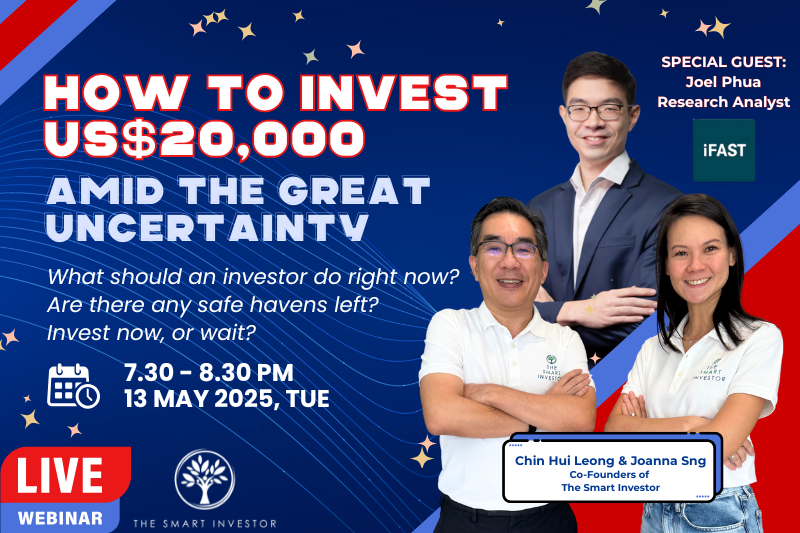I started investing in 2010 and have learnt a lot along the way. Today, I would like to share with you 31 lessons, so that you, dear reader, can become a smarter investor.
Market facts
- There are many hucksters out there. Always ask for their track record. How many “students” they have, how long they have been in the business, or much money they are managing does not matter. The key is, how have they done over a long period of time (five years and more)?
- Stocks represent part ownership of a living, breathing business.
- If a business does well over time, its stock price will too, eventually; if a business does poorly, its stock price will too.
- Developed economy stocks have climbed by 8.2% per year from 1900 to 2018 – this turns $1,000 into $10.9 million. Emerging economy stocks have climbed by 7.2% per year from 1900 to 2018 – this turns $1,000 into $3.7 million.
- But stocks have been volatile over the short run – it happens to even the best of stocks.
- From 1997 to 2018, the peak-to-trough decline for Amazon.com (NASDAQ: AMZN) in each year has ranged from 12.6% to 83.0%, meaning to say that Amazon had experienced a double-digit peak-to-trough fall every year. Over the same period, Amazon has seen its stock price climb from $1.96 to $1,501.97, for an astonishing gain of over 76,000%.
- It makes sense for stocks to be volatile. If stocks went up 8% per year like clockwork without volatility, investors will feel safe, and safety leads to risk-taking. In a world where stocks are guaranteed to give 8% per year, the logical response from investors would be to keep buying them, till the point where stocks simply become too expensive to continue returning 8%, or where the system becomes too fragile with debt to handle shocks. Thing is, there are no guarantees in the world. Bad things happen from time to time. And when stocks are priced for perfection, any whiff of bad news will lead to tumbling prices.
- Investing in stocks allows you to be a silent partner to some of the best businessmen and investors on the planet.
Investing psychology
- There are always things to worry about and the future is always uncertain. But that does not mean we shouldn’t invest.
- The past 53 years from 1965 to 2018 included the Vietnam War, the Black Monday stock market crash (when US stocks fell by more than 22% in a day), the “breaking” of the Bank of England (when the UK was forced to allow the pound to have a floating exchange rate), the Asian Financial Crisis, the bursting of the Dotcom Bubble, the Great Financial Crisis, Brexit, and the US-China trade war. But in those 53 years, the book value of Warren Buffett’s Berkshire Hathaway (NYSE: BRK-A) grew by 18.7% per year while its stock price increased by 20.5% per year. An 18.7% input has still led to a 20.5% output despite all these things to worry about.
- Loss aversion is a psychological bias most people have where a loss feels twice as painful as an equivalent gain. Put in place systems to help you deal with the psychological pain when stocks fall from time to time.
- The most important organ for investing is not the brain, but the stomach. We must not be scared off by short-term declines.
How to invest
- Your underlying investment philosophy has to be built on the idea that stocks represent part ownership of a living, breathing business. And there are times when a stock has a price that’s significantly lower than the value of its underlying business – investing is about identifying these instances!
- There are many different ways to invest with the philosophy above. The three broad categories are: (a) Finding a large group of stocks that are cheap based on their financial statements; (b) Finding a handful of stocks that are cheap based on their financial statements and appraisal of their current business conditions; and (c) Finding stocks that are cheap based on how well their businesses may do in the future.
- There are three financial statements every listed company must report: (a) Income statement; (b) Balance sheet; and (c) Cash flow statement.
- The income statement measures how much sales a company makes, and how much profit the company makes; the balance sheet tells us what a company owns, and what it owes; the cash flow statement tells us how much cash a company brings in. It’s important to have basic accounting knowledge so you can track the progress of a company. Each financial statement has many important things to look at, but there are a few that are critical.
- Critical things for the income statement: Revenue (how much sales a company makes); gross profit margin; operating profit margin; net profit margin; net profit (what’s left from sales after deduction of all expenses); we typically want fat gross margins, fat operating margins, and fat net profit margins.
- Critical things for the balance sheet: Level of cash; level of debt; we typically want cash to be significantly higher than debt; slightly less important things are total assets (what the company owns), total liabilities (what the company owes), and total equity (total assets minus total liabilities)
- Critical things for the cash flow statement: Operating cash flow (the cash flow generated from the company’s normal business operations); capital expenditure (what the company has spent to maintain its business at the current state); we typically want high operating cash flow and low capital expenditure; the difference between operating cash flow and capital expenditure is free cash flow – the higher the better.
- Going back to point 14, I will focus mainly on the third broad category on how to invest: Finding stocks that are cheap based on how well their businesses may do in the future. A few quick words on the first and second broad categories of investing …
- Finding a large group of stocks that are cheap based on their financial statements: It focuses on finding a large group of stocks with share prices that are low in relation to their net profit and/or their total equity, and buying an entire basket of them. This basket is typically held for anywhere from a quarter to two-years, and the search-and-investing process is then repeated.
- Finding a handful of stocks that are cheap based on their financial statements and appraisal of their current business conditions: It focuses on the analysis of a company’s business and financials to determine its underlying intrinsic value (nearly always how much cash it can generate from now to eternity, discounted back to the present), and then buying only a small handful of stocks with share prices that are much lower than their underlying intrinsic values.
- The third broad category – finding stocks that are cheap based on how well their businesses may do in the future – is where I have found the most success in, and find the most intellectually stimulating. To do well in this area requires two very important things: (a) Patience, because share prices need time to reflect the strengths of the business, and because compounding takes time, and (b) a strong stomach to withstand volatility.
- I find stocks with all or most of the following characteristics: (1) Revenues that are small in relation to a large and/or growing market, or revenues that are large in a fast-growing market; (2) Strong balance sheets with minimal or reasonable levels of debt; (3) Management teams with integrity, capability, and an innovative mindset; (4) Revenue streams that are recurring in nature, either through contracts or customer-behaviour; (5) A proven ability to grow; (6) A high likelihood of generating a strong and growing stream of free cash flow in the future.
- Revenues that are small in relation to a large and/or growing market, or revenues that are large in a fast-growing market. This criteria is important because we want companies that have the capacity to grow. An example of a company with a smaller revenue in relation to a fast-growing market is, believe it or not, Facebook (NASDAQ: FB) – a company that I own. Facebook’s revenue over the last 12 months is US$63 billion; global digital advertising spending was US$280 billion in 2018 and expected to grow to US$518 billion in 2023; global advertising spending was US$617 billion in 2018. An example of a company that I own with large revenues in relation to a fast-growing market is Intuitive Surgical (NASDAQ: ISRG). Intuitive Surgical’s revenue over the last 12 months was US$4.0 billion, while the global robotic surgery market was around US$4.8 billion, and expected to grow by over 20% per year over the next five years. Intuitive Surgical’s systems handled 1.04 million surgical procedures in 2018, while there are easily hundreds of millions of surgical procedures done each year.
- Strong balance sheets with minimal or reasonable levels of debt. This is important because strong finances enables a company to achieve three things: (1) Invest for growth, (2) withstand tough times, and (3) gobble market share during rough conditions. Haw Par Corporation Ltd (SGX: H02), which owns the Tiger Balm brand, is an example with S$408 million in cash, and just S$24 million in debt currently.
- Management teams with integrity, capability, and an innovative mindset. A management team without capability is bad for self-explanatory reasons; without an innovative mindset, a company can easily be left behind by the competition or run out of room to grow; a management team without integrity can fatten themselves at the expense of shareholders. An example of a management team without integrity is one that still pays themselves well even when the company’s business results have been bad over time. An example of a company with an innovative mindset will be Netflix (NASDAQ: NFLX), another company in my portfolio. Co-founder and CEO Reed Hastings said in 2007: “We named the company Netflix for a reason; we didn’t name it DVDs-by-mail.” This shows that the company was already thinking about building a video streaming business right from the very beginning, back when video streaming wasn’t even a widely used term.
- Revenue streams that are recurring in nature, either through contracts or customer-behaviour. Having recurring business is a beautiful thing because it means a company need not spend its time and money looking to remake a past sale. Instead, past sales are recurring, and the company is free to find brand new avenues of growth. A stock from my portfolio, Adobe (NASDAQ: ADBE), has recurring, subscription services for software used in many different areas including digital marketing and creation of digital content. 88% of Adobe’s US$8 billion in revenue in 2018 came from subscriptions. Recurring revenue from customer behaviour is embodied by Mastercard (NYSE: MA), another stock holding of mine. Each time you swipe your Mastercard credit card, the company earns a fee; in 2018, Mastercard processed US$5.9 trillion in payments (that’s a lot of swiping!). An example of a business with no recurring revenue is Sembcorp Marine (SGX: S51) – it builds expensive oil rigs that last for decades, and has to keep hunting for buyers of new oil rigs.
- A proven ability to grow. It’s important that a company has shown that it’s able to grow. And by growth, we’re looking at big jumps in revenue, net profit, and free cash flow over time. Sometimes, just revenue and free cash flow is good enough. A great example of a company with an excellent track record of growth is one of my holdings, Amazon. From 2013 to 2018, revenue tripled from US$74 billion to US$233 billion, while free cash flow jumped nearly nine times from US$2 billion to US$17 billion. PayPal Holdings (NASDAQ: PYPL), another holding of mine, is another example. From 2013 to 2018, revenue more than doubled from US$6.7 billion to US$15.5 billion, profit rose from US$1 billion to US$2 billion, and free cash flow increased from US$1.6 billion to US$4.7 billion.
- A high likelihood of generating a strong and growing stream of free cash flow in the future. The actual value of a company is the amount of cash it can generate over its entire life. So, the more free cash flow a company can generate, the more valuable it is. A good example of a company that embodies this trait is Alphabet (NASDAQ: GOOGL), parent of Google, and a stock in my portfolio. Alphabet has a strong history of generating free cash flow, and likely can continue doing so in the future, since the advertising business of Google is so lucrative (and as mentioned earlier, digital advertising is a huge and growing market). From 2013 to 2018, Alphabet’s free cash flow increased from US$11.3 billion to US$22.8 billion.
- Bonus last point: All the positive examples of companies mentioned in Points 25 to 30 actually meet all or most of the six criteria!
If you’d like to learn more tips on how to be a smarter investor, click HERE to subscribe to our Free investing newsletter, Get Smart! We’ll show you how you can build a better financial future for you and your family.
None of the information in this article can be constituted as financial, investment, or other professional advice. It is only intended to provide education. Speak with a professional before making important decisions about your money, your professional life, or even your personal life.




